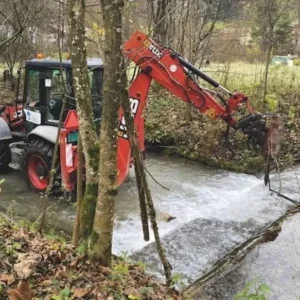Recent major power plant installations of Single Row Condensing systems include the Sutton Bridge combined cycle plant in the UK (780 MWe), due to start up next year, and Herdersbrug in Belgium (460 MWe), also combined cycle, which has just recently entered service.
In the single row concept, the multiple rows of tubes used in previous condenser designs are replaced with one large tube, which is flat rather than of circular or elliptical cross section. The flat tubes are aluminium clad and finned.
Among the advantages of the single row technology compared with multiple row designs are
Non-freezing. Due to uniform steam distribution, single row systems are virtually freeze proof. In contrast, tubes in multirow condensers suffer from non-uniform performance, due to warming of the cooling air as it travels across the various rows. This causes backflow of steam into lower tube row(s) resulting in air accumulation, flooding, subcooling and freezing.
Increased power generation. Low turbine backpressure can be maintained during winter conditions without risk of freezing, resulting in increased generation.
Lower fan power consumption. The tube shape and fin characteristics result in reduced pressure drop on the air side, leading to less power consumption by the fan motors.
Increased thermal efficiency. Increased heat exchanger efficiency means fewer modules are needed for a given duty. This reduces site area, cabling, equipment needed, maintenance requirements, control systems etc.
Recent development work on the Hamon-Lummus single tube technology has focused on achieving faster construction times, through increased modularization and maximum factory assembly. The revised construction sequence was used for the first time on the 36 module Herdersbrug project. Erection of the cooling system started in June 1996 and was completed in 11 months. Increased modularization is estimated to provide 20 per cent time savings compared with the previous method.
Natural draft
The next logical step in the evolution of the single row concept would be to combine it with natural draft cooling – an idea that has been around for some time but not yet implemented, due to lack of economic incentive. The single row technology would be a particularly good fit with natural draft cooling because of the increased thermal performance and the reduced ground area and equipment requirements.
Although natural draft technology entails greater initial capital expenditure than a conventional single row system with forced cooling, total costs considered over the plant lifetime, appear to favour the natural draft solution (see, for example, paper presented by Hamon at the June 1998 Power Gen meeting in Milan). A project combining single row and natural draft technology is expected to be given the go-ahead in near future.






